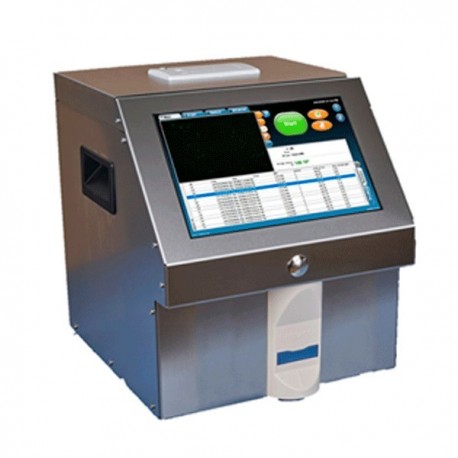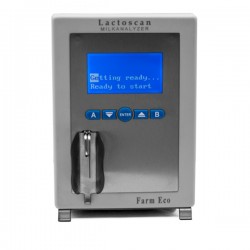No products
Prices are tax excluded
Somatic Cell Counter LACTOSCAN SCC
LACTOSCAN SCC
New product
Brand: Milkotronic/ Lactoscan
Lactoscan SCC is a low-cost device, designed to detect somatic cells in milk samples, based on fluorescent image counts with analysis time of less than 1 minute.
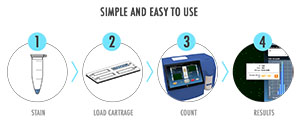
- Write a review
- Remove this product from my favorite's list.
- Add this product to my list of favorites.
More info
Thanks to fluorescent dye, LED optics and CCD technology to capture images. Lactoscan SCC is accurate, reliable and fast for analyzing somatic cells in milk.
WORLDS LOWEST COST PER TEST
The high precision image fluorescence somatic cell counting is now affordable even for small farmers, dairies and local dairy laboratories. A recomend price of 0,30€/ test.
Key Features:
- High-end direct fluorescent, low magnification microscope with fast autofocus and cell counting software
- Fast, accurate, reliable somatic cells analysis of cow, sheep, goat, buffalo and human milk
- Possibility of reference analysis
- Detects subclinical and clinical mastitis
- Lowest cost per test of Somatic Cell Counts
- Easy readable results within 20 to 60 seconds
- Takes a maximum of 60 images by computer controlled X:Y movements and then processes these by the image analysis software
- Stores unlimited number of record in the database
- Results are color coded
- Automatic software update and remote service
- Portable and compact design
- 7'' fully functional touchscreen tablet
- Embedded printer
- Wireless keypad and mouse
- Use of 4 channels disposable LACTOCHIPS
- Low power consumption
- User-friendly: simple in operation, maintenance, calibration and installation
- Very small quantity of milk required
- Low power consumption
- No use of hazardous chemicals
- One year full waranty
- Measuring accuracy adjustment can be done by the user RS 232 Interface
- One year full warranty
Milkotronic Ltd. has developed a portable Lactoscan SCC based on direct fluorescent, low magnification microscopic somatic cell counting. Lactoscan SCC uses a very sensitive fluorescent dye Sofia Green, LED optics и CMOS technologies for capturing in order to make the cells analysis more accurate, reliable and fast. Mostly, the objective selectiveness of Lactoscan SCC is combined with the permanent high stability of the different mechanical, electronic, optical and chemical components of the system, which provides almost identical results during the whole duration of machine’s use. On top of that, the production of the machines provides high level of uniformity between the devices. This is a unique feature of Lactoscan SCC which actually offers identical results when we consider the measurement of one and the same sample, notwithstanding which machine is used, what is the location, who is using the machine, and in what moment the analysis is being made, in case that the characteristics of the samples have not changed.
In order to count the somatic cell with Lactoscan SCC, the milk sample is mixed with the dying reagent, containing fluorescent dye Sofia Green. Only 8 μL from the dyed sample is pipetted on the measuring chamber of disposable LACTOCHIP. The chip is loaded into the device and for a period between few seconds and 2 minutes, depending on the measuring mode, the analysis is done. Lactoscan SCC system focuses automatically on the chip and the dyed cells are captured by the sensitive CMOS camera. The analysis algorithm of digital images determines the number and dimension of the fluorescent cells and counts their concentration. The results are automatically shown on the display, also on printer, with possibility to save the results and generate reports from the results.
Results from analysis
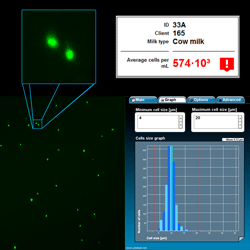
- Analysis time: 20-60 sec
- Measuring range: 0 - 10 000 000 cell/ml
- Measuring cell size range: 2-30 µm
- Colour indication for sub-clinical and clinical mastitis
Coefficient of variation
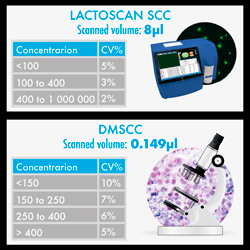
- LACTOSCAN SCC possesses the largest volume of scanned sample up to 9 µl that guarantee low coefficient of variation, better than the direct microscopic counting.
Verification as microscope
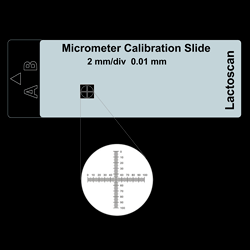
- There is no need of calibration, only a graduated scale on a LACTOCHIP is used for verification of the magnification as per requirements of ISO 13366-1:2008 (IDF 148-1:2008) Milk -- Enumeration of somatic cells -- Part 1: Microscopic method (Reference method).
The Somatic Cell Counter LACTOSCAN SCC is sent with the following items:
- #1 LACTOSCAN SCC Somatic Cells Counter
- #1 LACTOSCAN SCC STARTER KIT
- #1 LACTOSCAN SCC 12V power cable
- #1 LACTOSCAN SCC Quick Start Guide
- #1 Automatic pipette up to 100 µL – set at 8 µL
- #1 Automatic pipette up to 100 µL – set at 100 µL
- #1 USB wireless keyboard with batteries
- #1 USB wireless mouse with batteries
- #1 Mini Vortex
METHOD
LACTOSCAN SCC Somatic cell counter is based on fluorescent image cytometry for counting cells in milk. It fully comply with the ISO 13366-1 IDF 148-1 Enumeration of somatic cells - Microscopic method (Reference Method) with regard to the staining of cells, in the definition of cells to be counted depending on the size and the methodology of the counting. The somatic cell counter offers visual control for excluding accidental errors. The measuring range of the counter is 2 to 30 µm and the results are expressed as number of cells per mL. The results are available within 20 to 60 seconds depending on the type of analysis. There is no need of calibration, only a graduated scale on a LACTOCHIP is used for verification of the magnification as per requirements of ISO 13366-1:2008 (IDF 148-1:2008) Milk -- Enumeration of somatic cells -- Part 1: Microscopic method (Reference method).
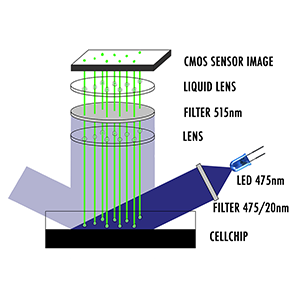
Working principle of LACTOSCAN SCC
Unique, 3D, multi-image, patent application protected, sequential scanning process, based on a precise fluorescent optics and low magnification, images analysis software, LACTОSCAN SCC is fast, precise and reliable counter of somatic cells. Via automatic displacement of the mechanism on axles X – Y and liquid lens Z, the device is capturing maximum 60 images. After capturing, the images are being processed by the embedded software and the average result, calculated by using the formula from IDF/ISO 13366, of all the filmed images is displayed. The whole process, after placing the LACTOCHIP in the cartridge, is automatic.
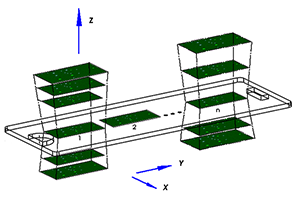
LACTOSCAN SCC compared with a standard methods for Somatic Cells Counting
The below described data are based on validation and check of LACTOSCAN SCC done by the “Biotechnologies” department of University “Prof. Asen Zlatarov”, Bulgaria
1. Accuracy of analysis – comparison between LACTOSCAN SCC and Direct microscopic counting of somatic cells (DMSCC)
Images of somatic cells (LACTOSCAN SCC)
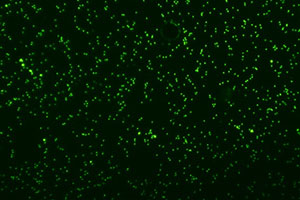
Images of somatic cells (DMSCC)
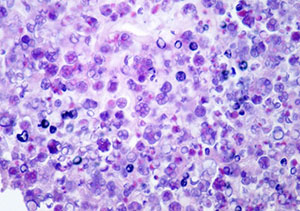
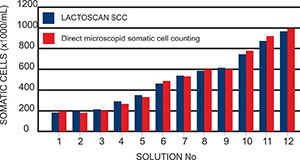
| LACTOSCAN SCC | Standard method | |||
| NSC (cells/ml) | CV % | NSC (cells/ml) | CV % | |
| 100 000 | 5% | 100 000 | 7% | |
| 500 000 | 3% | 400 000 | 5% | |
| 1 000 000 | 2% | 600 000 | 4% |
2. Compatibility – ratio between data from LACTOSCAN SCC and DMSCC
Somatic cells count
The number of somatic cells (SCC) is one of the internationally recognized standards for milk quality control and is also a useful indicator for mastitis presence. There are several different methods for determination the total number of somatic cells in milk (SCC). Each method is based on different feature and exploitation characteristics, but none of them is capable of determining the total number of somatic cells. In case of perfect conditions it is possible to determine the SCC of a milk sample, but there are several theoretical and practical problems, that make it impossible, especially when automation and speed of analysis are required. Because of the random positions of the cells in the sample, each result, unless total sample is tested, may only indicate a part of the SCC. SOFIA GREEN fluorescent dye.
Determination the number of the somatic cells in raw milk
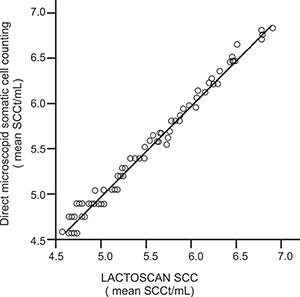
See comparation Lactoscan SCC automated microscope based on image cytometry vs Direct Microscopic Somatic Cell Count
Know more about Somatic cells count
Safe non-mutagenic fluorescence cyanine SOFIA GREEN dye
For the yeast cell analysis, we synthesized our own innovative fluorescence dye named SOFIA GREEN. It is last generation non-mutagenic fluorescence cyanine dye and is safety for use. The dye bound to the DNA of the cells for a very short period of time, several times shorter than compared to other fluorescence dyes.
Once the stained DNA is lightened with LED light, it emitted green light. The dye is 15 times brighter than the propidium iodide and is with very low background noise. The dye is used for somatic cell count with LACTOSCAN SCC and yeast cell count with EASYCOUNTER YC.
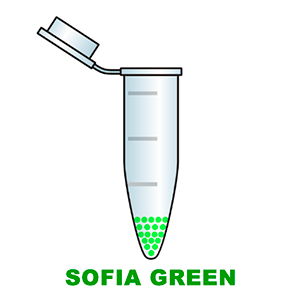
Reviews
1 other product in the same category:


